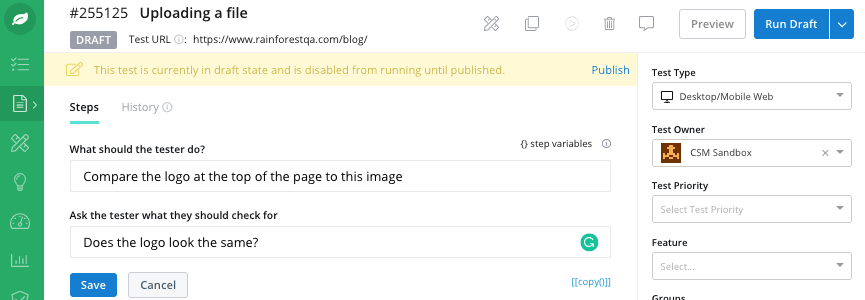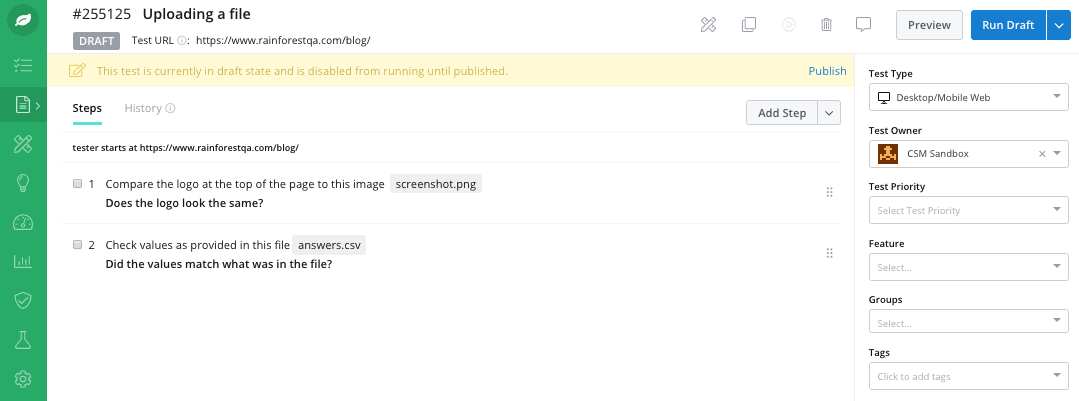Inserting Screenshots and Downloadable Files
Learn how to provide testers with screenshots and files in Plain-Text Editor tests.
There are two ways to upload a file into a Plain-Text Editor test. This article shows you how to do this via the Rainforest app. For information on using the command line, refer to the Rainforest CLI documentation.
Embedding Files
- Hover over a step and click the pencil icon to edit the step.
- Drag a file from your file location to the text field. A plus sign (+) appears while hovering over the field.
- Once you drag-and-drop the file, it’s assigned a file number and enclosed in double braces
. - Click the Save button. The file name converts to a gray box. Testers now have access to the file.

Uploading a file using the Rainforest app.
Providing a URL to the File
- Insert a step that links to the file on the hosting service.
- Provide instructions on downloading a file or viewing a screenshot.
ExampleAction: Open a new tab and go to nshot. Question: Were you able to view the image or download the file?
Previewing and Downloading the Screenshot
When you add a non-image file (.csv, .doc, .txt) to a test step, it auto-formats as a downloadable file {file.download(x,x)} instead of a screenshot {file.screenshot(x,x)}. While your test is in edit mode, the file is downloadable.

Working with uploaded files.
Making Image Files Downloadable
By default, image files (.jpeg, .png, .gif) are auto-formatted as screenshots. To allow the tester to download an image, change its file name in the text box. Make sure to provide instructions on how to use the image.
- In the file name,
{ file.screenshot(x,x) }, replace “screenshot” with “download.” - Update the name or leave the default.
- Add a comma and space.
- Add the file type such as .png or jpg.
ExampleOriginal Image:
{ file.screenshot(177510, nKcjvM) }Downloadable:{ file.download(177510, nKcjvM, **file.png**) }
Note: You can’t force a downloadable file to be an image file. Nor can you make an image file downloadable via a URL.
Viewing PDF Files
Rainforest testers can view PDF files in Rainforest virtual machines via apps preinstalled on the VM.
Windows OS
VMs running Windows (Chrome HD, Firefox HD, Internet Explorer 11 HD) come with Adobe Acrobat Reader preinstalled to allow testers to view PDFs.
MacOS
VMs running macOS (macOS Chrome HD, macOS Firefox HD, Safari HD), do not come with a dedicated application for reading PDFs. To open a PDF in one of these VMs, use the Preview app.
iOS
iOS devices have no preloaded PDF apps. To view a PDF, use the device’s Safari browser.
Android
Android VMs come preinstalled with a PDF viewer. After testers download the PDF, it automatically opens and can be accessed in the Files app. Note that you might need to instruct testers to allow Chrome to access the device’s photos, files, and other media.
If you have any questions, reach out to us at [email protected].
Updated 3 months ago